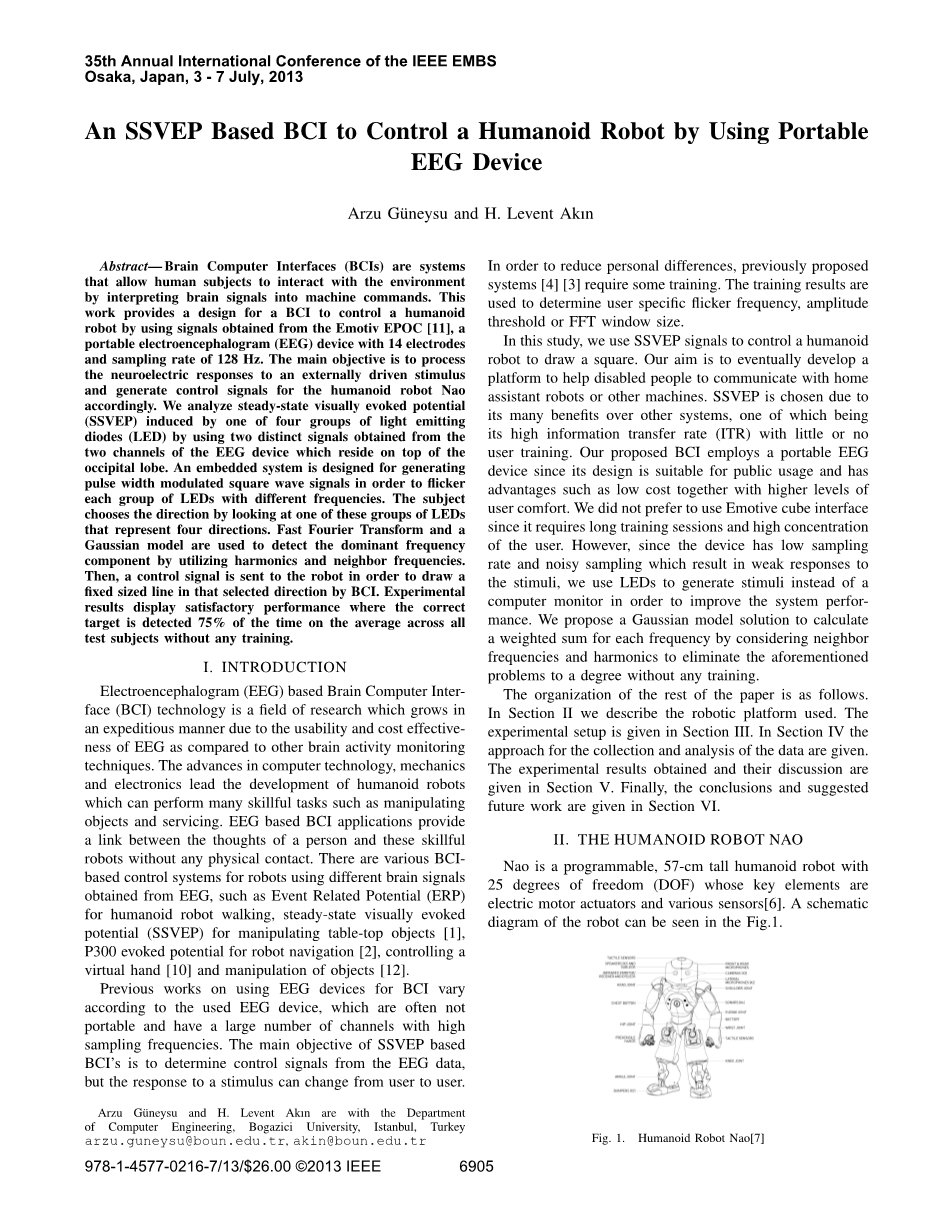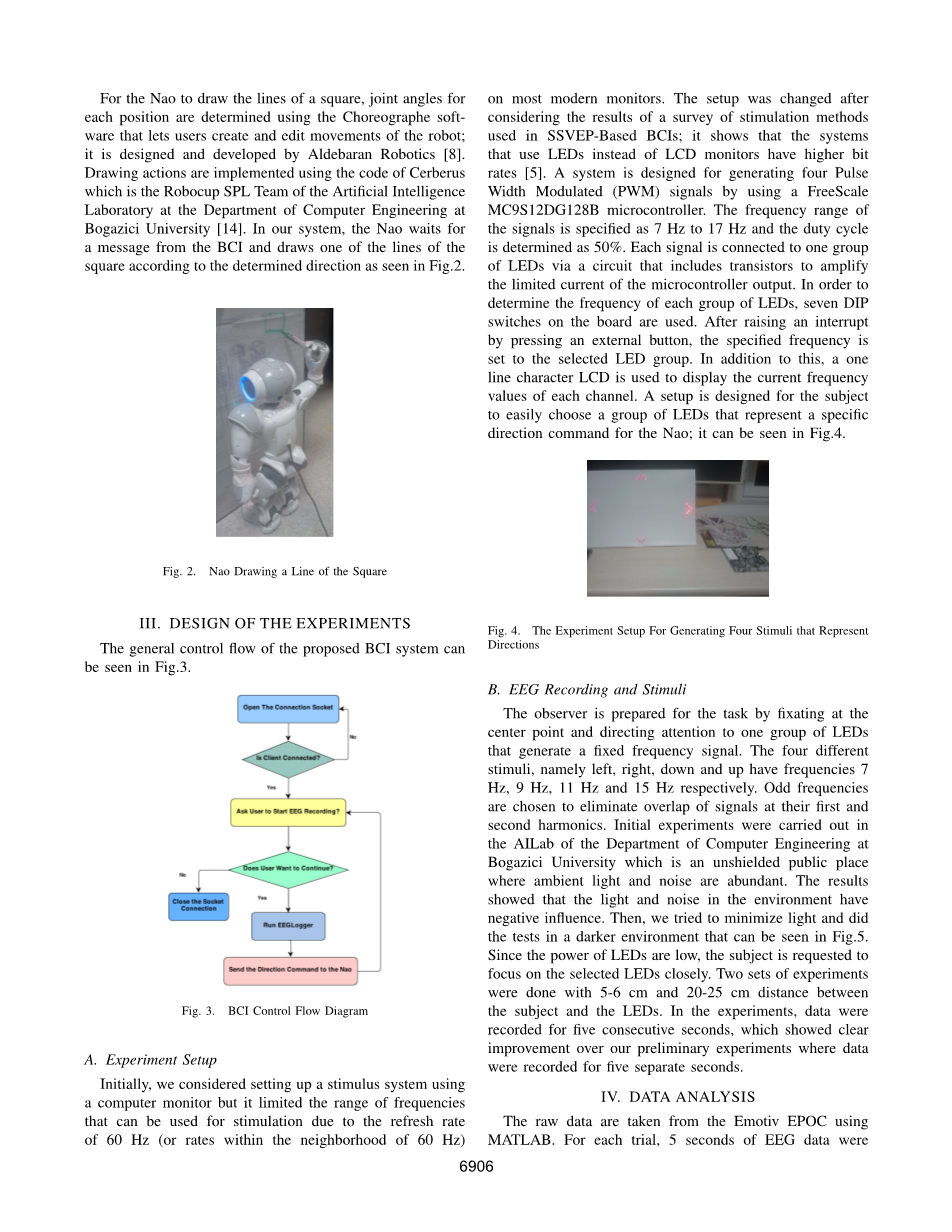

英语原文共 4 页
An SSVEP Based BCI to Control a Humanoid Robot by Using Portable EEG Device
基于SSVEP的BCI便携式脑电提取设备控制人形机器人
Abstract—Brain Computer Interfaces (BCIs) are systems that allow human subjects to interact with the environment by interpreting brain signals into machine commands. This work provides a design for a BCI to control a humanoid robot by using signals obtained from the Emotive EPOC [11], a portable electroencephalogram (EEG) device with 14 electrodes and sampling rate of 128 Hz. The main objective is to process the neuroelectric responses to an externally driven stimulus and generate control signals for the humanoid robot Nao accordingly. We analyze steady-state visually evoked potential (SSVEP) induced by one of four groups of light emitting diodes (LED) by using two distinct signals obtained from the two channels of the EEG device which reside on top of the occipital lobe. An embedded system is designed for generating pulse width modulated square wave signals in order to flicker each group of LEDs with different frequencies. The subject chooses the direction by looking at one of these groups of LEDs that represent four directions. Fast Fourier Transform and a Gaussian model are used to detect the dominant frequency component by utilizing harmonics and neighbor frequencies. Then, a control signal is sent to the robot in order to draw a fixed sized line in that selected direction by BCI. Experimental results display satisfactory performance where the correct target is detected 75% of the time on the average across all test subjects without any training.
抽象脑计算机接口(BCI)是通过将脑信号解释为机器命令而允许人类对象与环境交互的系统。 这项工作为BCI提供了一种设计,通过使用从Emotiv EPOC [11]获得的信号来控制人形机器人,这是一种带有14个电极和128 Hz采样率的便携式脑电图(EEG)设备。 主要目的是处理对外部驱动的刺激的神经电响应,并相应地为人形机器人Nao产生控制信号。 我们通过使用从位于枕叶顶部的EEG装置的两个通道获得的两个不同信号来分析由四组发光二极管(LED)之一引起的稳态视觉诱发电位(SSVEP)。 嵌入式系统被设计用于产生脉冲宽度调制的方波信号,以便以不同的频率对每组LED进行闪烁。 受试者通过查看代表四个方向的这些LED组中的一个来选择方向。 快速傅里叶变换和高斯模型用于通过利用谐波和相邻频率来检测主频分量。 然后,控制信号被发送到机器人,以便通过BCI在该选定方向上绘制固定尺寸的线。 实验结果显示出令人满意的性能,其中在没有任何训练的情况下在所有测试对象上平均75%的时间检测到正确的目标。
INTRODUCTION
简介
Electroencephalogram (EEG) based Brain Computer Interface (BCI) technology is a field of research which grows in an expeditious manner due to the usability and cost effectiveness of EEG as compared to other brain activity monitoring techniques. The advances in computer technology, mechanics and electronics lead the development of humanoid robots which can perform many skillful tasks such as manipulating objects and servicing. EEG based BCI applications provide a link between the thoughts of a person and these skillful robots without any physical contact. There are various BCI based control systems for robots using different brain signals obtained from EEG, such as Event Related Potential (ERP) for humanoid robot walking, steady-state visually evoked potential (SSVEP) for manipulating table-top objects [1], P300 evoked potential for robot navigation [2], controlling a virtual hand [10] and manipulation of objects [12]. Previous works on using EEG devices for BCI vary according to the used EEG device, which are often not portable and have a large number of channels with high sampling frequencies. The main objective of SSVEP based BCIrsquo;s is to determine control signals from the EEG data, but the response to a stimulus can change from user to user.
基于脑电图(EEG)的脑计算机接口(BCI)技术是一个研究领域,由于与其他大脑活动监测技术相比,EEG的可用性和成本效益,其迅速发展。 计算机技术,机械和电子技术的进步引领了人形机器人的发展,这些人形机器人可以执行许多熟练的任务,例如操纵物体和维修。 基于脑电图的BCI应用程序提供了一个人的思想与这些熟练的机器人之间的联系,而没有任何身体接触。 基于BCI的各种控制系统用于使用从EEG获得的不同脑信号的机器人,例如用于人形机器人行走的事件相关电位(ERP),用于操纵桌面物体的稳态视觉诱发电位(SSVEP)[1],P300诱发机器人导航的潜力[2],控制虚拟手[10]和操纵物体[12]。 以前关于将BEG用于EEG设备的工作根据所使用的EEG设备而变化,所述EEG设备通常不是便携式的并且具有大量具有高采样频率的信道。 基于SSVEP的BCI的主要目的是确定来自EEG数据的控制信号,但是对刺激的响应可以在用户之间变化。
In order to reduce personal differences, previously proposed systems [4] [3] require some training. The training results are used to determine user specific flicker frequency, amplitude threshold or FFT window size.
为了减少个人差异,以前提出的系统[4] [3]需要一些培训。 训练结果用于确定用户特定的闪烁频率,幅度阈值或FFT窗口大小。
In this study, we use SSVEP signals to control a humanoid robot to draw a square. Our aim is to eventually develop a platform to help disabled people to communicate with home assistant robots or other machines. SSVEP is chosen due to its many benefits over other systems, one of which being its high information transfer rate (ITR) with little or no user training. Our proposed BCI employs a portable EEG device since its design is suitable for public usage and has advantages such as low cost together with higher levels of user comfort .We did not prefer to use Emotive cube interface since it requires long training sessions and high concentration of the user. However, since the device has low sampling rate and noisy sampling which result in weak responses to the stimuli, we use LEDs to generate stimuli instead of a computer monitor in order to improve the system performance. We propose a Gaussian model solution to calculate a weighted sum for each frequency by considering neighbor frequencies and harmonics to eliminate the aforementioned problems to a degree without any training.
在这项研究中,我们使用SSVEP信号来控制人形机器人绘制正方形。 我们的目标是最终开发一个平台,帮助残疾人与家庭助理机器人或其他机器进行通信。 选择SSVEP是因为它对其他系统有很多好处,其中之一就是它的高信息传输率(ITR),很少或没有用户培训。 我们提议的BCI采用便携式EEG设备,因为其设计适合于公共使用,并且具有诸如低成本和更高水平的用户舒适性的优点。我们不喜欢使用Emotive cube界面,因为它需要很长的训练时间和高度集中的用户。 然而,由于该装置具有低采样率和噪声采样,导致对刺激的弱响应,我们使用LED来产生刺激而不是计算机监视器以改善系统性能。 我们提出了一种高斯模型解决方案,通过考虑相邻频率和谐波来计算每个频率的加权和,从而在没有任何训练的情况下消除上述问题。
The organization of the rest of the paper is as follows. In Section II we describe the robotic platform used. The experimental setup is given in Section III. In Section IV the approach for the collection and analysis of the data are given. The experimental results obtained and their discussion are given in Section V. Finally, the conclusions and suggested future work are given in Section VI.
本文其余部分的组织如下。 在第二节中,我们描述了使用的机器人平台。 实验设置在第三节中给出。 在第四节中,给出了收集和分析数据的方法。 实验结果
以上是毕业论文外文翻译,课题毕业论文、任务书、文献综述、开题报告、程序设计、图纸设计等资料可联系客服协助查找。


